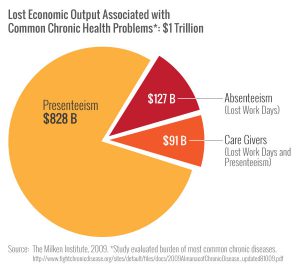Businesses are a major provider of health insurance in the U.S., yet rising health care costs are making it increasingly difficult for employers to afford coverage. Employee health benefits are the fastest growing cost component for many employers and represent an increasingly large percentage of total work force costs.
The prevalence of chronic disease within the U.S. work force is a key source of these challenges. Not only does a sicker U.S. workforce have higher health care costs, but it is also less productive. Chronic disease leads to absenteeism and presenteeism – decreased productivity at work. These problems now cost U.S. businesses $1 trillion per year.
Direct and indirect costs of chronic disease

Absenteeism¹
Extensive work absence is associated with respiratory diseases:
Chronic Obstructive Pulmonary Disease (COPD)
3 weeks absent per year
Asthma
2.5 weeks absent per year
Allergies
1.2 weeks absent per year
Presenteeism²
According to the Partnership to Fight Chronic Disease, presenteeism is responsible for the largest share of lost economic output associated with chronic health problems. 21 percent of workers report that they have gone to work sick or burdened by a non-work issue six or more days in the last six months.
Family caregivers are a critical support structure for patients with a chronic illness. Family caregivers provide 80 percent of all long-term care services for chronically ill patients. In any given year, more than 50 million Americans find themselves in a caregiving role.
Employers pick up a large share of this cost when workers come to work sick, and when other workers are burdened by caring for a family member with chronic conditions.
The King’s cleaning for health reduces indoor air pollutants that contribute to respiratory chronic disease
In September 2009, the King’s completed a 90-day pilot project for a Houston-area medical clinic where a 31% reduction was documented in air particles down to 0.3 microns, including dust, dust mites, dust mite feces, dead skin cells, the H1N1 virus, fungal and mold spores, and harmful bacteria.
Armed with scientific data, The King’s employed a combination of work flow innovation and janitorial staff training to revolutionize the cleaning process in this medical clinic.
¹Financial Forecast Center; CCH Unscheduled Absence Survey, 2007 (http://hr.cch.com)
²2009 Almanac of Chronic Disease, Partnership to Fight Chronic Disease (http://www.fightchronicdisease.org/sites/default/files/docs/2009AlmanacofChronicDisease_updated81009.pdf)

